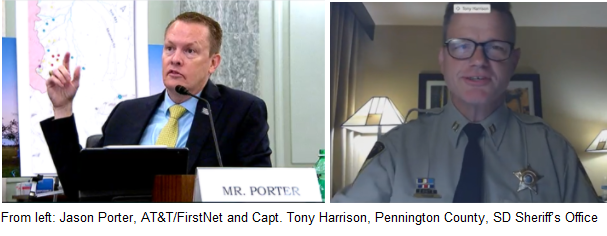FirstNet is not only helping first responders communicate in regular disasters, the broadband communications platform is also boosting communications needs in hospitals and other healthcare locations during the pandemic. Officials told Senators on the Communications, Technology, Innovation, and the Internet Subcommittee Thursday that FirstNet is making good progress on deployments as laid out in its contract with AT&T.
FirstNet is half-way through its initial five-year schedule. Jason Porter, senior vice president, FirstNet Program at AT&T, said the carrier finished installing Band 14 capability about a year early. He and FirstNet Executive Director Edward Parkinson agreed deployments lay the groundwork for 5G.
Concerning the pandemic, Porter said dealing with COVID has been like responding to a flood, fire or tornado in every city in the country at the same time. The communications platform for first responders includes healthcare workers, according to Porter, as he discussed efforts to provide communications on hospital ships and on tribal reservations.
Porter said first responders thanked FirstNet after Hurricane Sally hit Louisiana. AT&T brought in a 55-foot blimp to provide connectivity. “Public safety workers thanked FirstNet, saying we were the only ones there.” Now, AT&T is deploying generators and other assets, like drones and deployables on wheels, in fire camps out west for the wildfires in places where a tower is disabled. FirstNet has an app that members can use that tells them the exact location of the fire, people and deployables.” The real strength of FirstNet is we’re there when they need us most after disasters with our response operations group. We stage assets across the country so we can get them to where they’re needed,” Porter told lawmakers.
Captain Tony Harrison of the Pennington County South Dakota Sheriff’s Office urged lawmakers to help cut red tape for building communications infrastructure on federal land. He described searches for lost people in the Black Hills, where there is often no cell coverage. On a recent search, Harrison said, “We called FirstNet and they deployed a COLT and a dedicated band within hours.”
Two towers have been built in the Black Hills on U.S. Forest Service land and two more are being constructed, according to Harrison. “For us, time is the enemy,” he said, emphasizing one of the recent searches occurred in the area where a tower is being built.
Porter agreed the pandemic shows the importance of broadband, including in rural areas. “Our biggest challenge is gaining access” to sites, he said, “whether it’s at state local, state or federal level. It can take years to gain access…to dig a trench or build that tower,” especially in rural America. He asked the subcommittee to streamline the access process and procedures for rural buildout.
Asked what FirstNet does for local communities, Porter said when it deploys Band 14 on a military base, for example, it benefits the local area. “When that network is not congested, or seeing high traffic, the local community can join that band as a secondary user.” He described AT&T’s “single touch climb,” in which, “We climb the tower, we hang a Band 14 radio. We also hang general commercial radios.”
By Leslie Stimson, Inside Towers Washington Bureau Chief





Reader Interactions